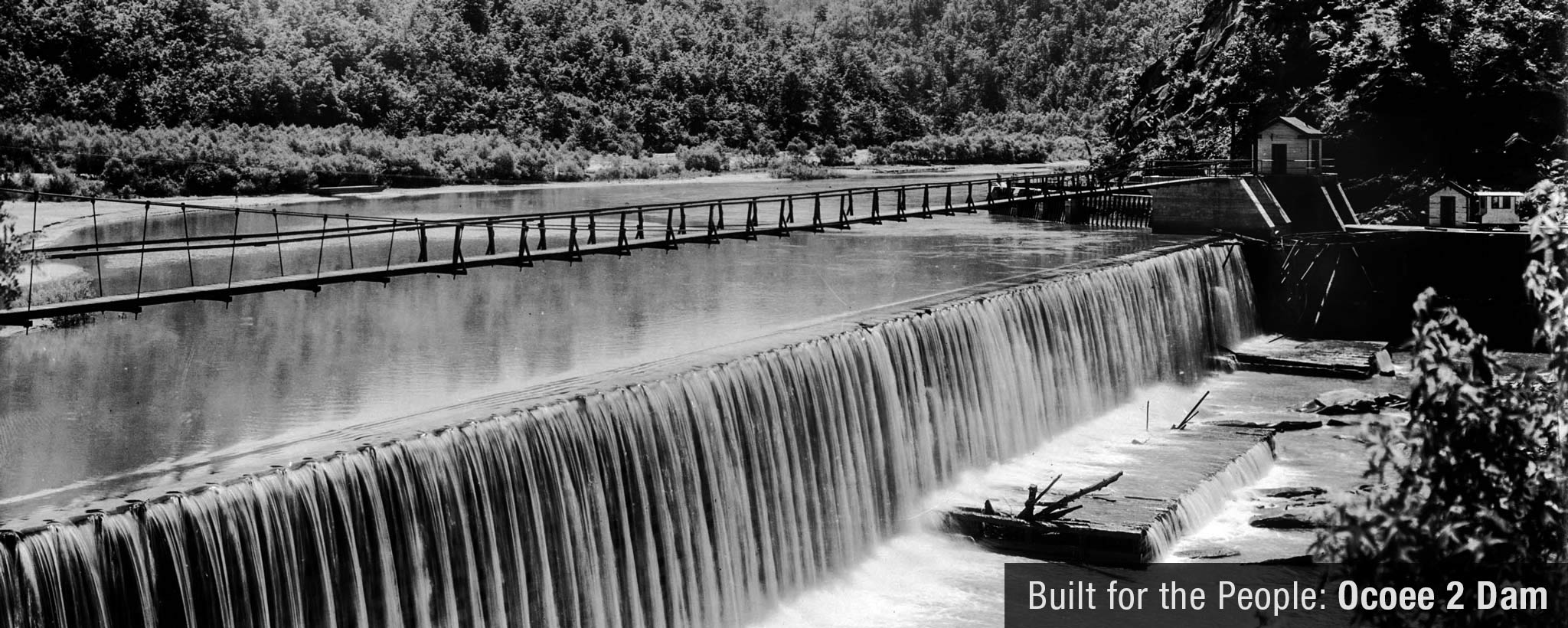
The Little Dam That Could
So it's not the linchpin of the TVA river system. Ocoee Dam No. 2 and its funky flume were front and center at the 1996 Olympics, and that flume is now ensconced on the National Register of Historic Places.
TVA didn't invent hydropower in the Tennessee Valley, of course. Waterwheels had been used at sawmills and grain mills all over the region since the 18th century.
And a little over a hundred years ago, companies began using hydropower to generate electricity here—sometimes going to great lengths to do so. In the 1930s, as TVA was setting up its Valley-wide complex of dams, it discovered one such remarkable system already in place in a remote corner of southeastern Tennessee.
Hydropower is based on gravity: the farther water falls, the more power it can generate. Water in a gently sloping stream dissipates its energy as it descends, and doesn’t produce nearly as much power as water falling from a great height. But nature doesn’t always put waterfalls just where you need them.
In 1912 the East Tennessee Power Company built a couple of modest-sized dams on the rugged Ocoee River, a fast-flowing stream that originates deep in Georgia. Below the site of one of the dams, Ocoee No. 2, the river ran as whitewater down its twisting bed, losing most of its potential energy as it splashed over the rocks.
The dam, which consisted of a timber crib filled with stone, would be only 30 feet high when completed, so by itself it didn’t offer much electricity-generating potential. But if engineers could somehow keep the water high up on the mountainside till it reached a place where it could plummet from a height of, say, 250 feet—a height rivaling that of any skyscraper in the region at the time—its power would be formidable.
The Big Solution
There was a sense of urgency about the project. A big new aluminum company called Alcoa was setting up shop in Blount County not far away, and the plant would need massive amounts of electricity for its manufacturing process. (In time, Alcoa became one of TVA’s biggest customers.)
The problem was that the ideal spot to build Ocoee No. 2’s power plant, the part of a dam that generates electricity, was nearly five miles downstream from the dam itself. By that point, the river’s bed had dropped to a level 250 feet below the height of the water behind the dam.
The power company’s engineers went to work. On a sort of shelf carved into the side of the mountain, they built a flume, or wooden trough, to carry the water from the dam down to the power plant.
The flume was of a size unprecedented in the region—about 14 feet wide and 11 feet deep, wider and deeper than most swimming pools. Descending just 19 feet on its five-mile course, barely enough to keep the water flowing, it arrived at a bluff where the water roared through two large steel pipes to the generating plant far below.
Ocoee No. 2 had been in operation for some 25 years by the time TVA acquired it in the late 1930s. TVA engineers admired the eccentric throwback to another time; they studied the system and found ways to improve its generating capacity by about 15 percent.
Impressed with the hydropower potential of the Ocoee River, TVA also built another small dam upstream, Ocoee No. 3, using the same hydrodynamic principles exploited at the earlier dam. Ocoee No. 3’s powerhouse is two and a half miles downstream from the dam. In this case, water is diverted through a tunnel rather than a flume, but as at the older dam, it generates significantly more power than it would have otherwise.
Preserving the Past
The flume at Ocoee No. 2 chugged away until 1976, when TVA shut it down for safety reasons—in part because it could no longer support the rails and handcar that topped the structure and were used to maintain it. There was talk of disabling the flume or removing it altogether.
But an outcry from preservationists, including some sentimental old engineers, saved this monument to early hydraulic engineering. With TVA’s help, it was placed on the National Register of Historic Places. TVA rebuilt the old flume with treated wood, and by 1983 it was back in business, as it is today. Parts of it are visible from U.S. Highway 64.Even the train track on the top was rebuilt; rather than a handcar, though, a propane-powered tram now patrols the flume.
The workers who run the three TVA dams on the Ocoee even enjoyed a few weeks of worldwide attention in the summer of 1996, during the Atlanta Olympic Games. The whitewater kayaking events were held on the Ocoee River, between dams No. 2 and 3.
Today the two generators at Ocoee No. 2 still use the flume system to produce 18 megawatts of electricity. TVA has modified the generating plant by adding new components and safety systems, but parts of the plant still date to the early 20th century.
Very few historic sites actually produce electricity. Thanks to TVA, Ocoee No. 2 is one of them.
